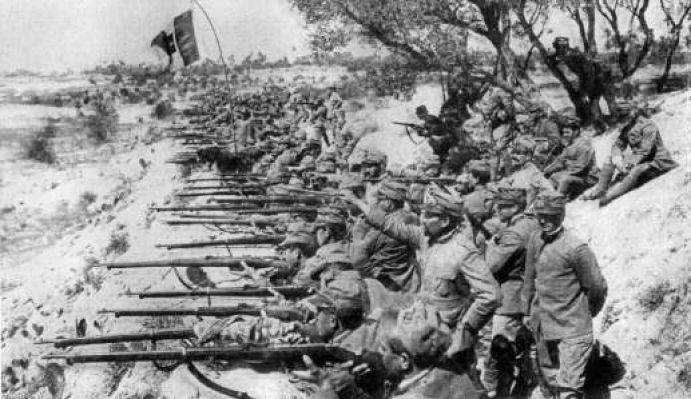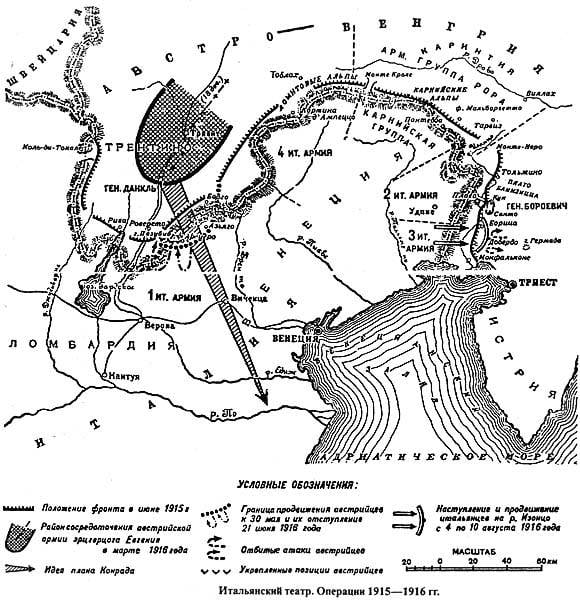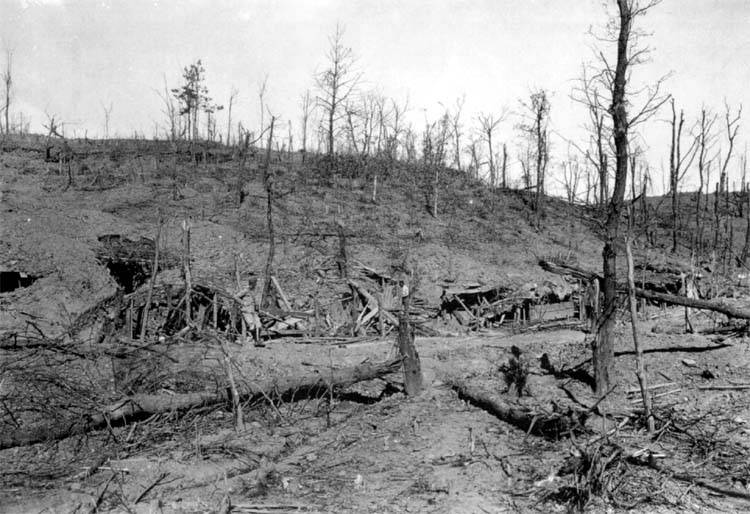Trentino operation

100 years ago, 15 May 1916, the Trentine operation began (the battle of Asiago). The Austro-Hungarian troops launched a powerful offensive on the Italian front from the Trentino area in order to encircle the main body of the Italian army on the Isonzo River. The defeat of the main forces of the Italian army could lead to the withdrawal from the war of Italy. The fighting also took place on the Isonzo River, where the Austrians fired strong artillery fire, aerial bombardments, and carried out attacks in a number of directions in order to bind the enemy forces in combat. The Austrian offensive began successfully, but by the end of May it was exhausted. The Brusilovsky breakthrough that started on the Eastern Front forced the Austro-Hungarian command to transfer forces from the Italian Front to the East.
The Italian commander-in-chief, Cadorna, strengthened the defenses of the 1 of the Italian army by transferring five corps, which allowed the Italians of 16 June to launch a counteroffensive. Weakened due to the transfer of significant forces to Galicia, the Austro-Hungarian troops began to withdraw to their previous positions. However, the Italian troops still failed to reach their previous positions, which they held before the start of the operation. By July 9, the Italian counter-attack in Trentino was also exhausted. As a result, both sides suffered heavy losses. However, Austria-Hungary was unable to bring Italy out of the war, thanks in large part to the Russian offensive on the Eastern Front. In Italy itself, the defeat at the initial stage of the battle made a heavy impression on the country's public, because of the defeat the government was forced to resign. True, the Italian army continued to prepare for the next (already the sixth) attack on the Isonzo, which began in August.
Before the battle. Austrian Command Plans
After additional mobilization and receiving new weapons, the Italian army in early March 1916 launched an offensive on the Isonzo River. However, the fifth battle of the Isonzo did not give the expected results. The Italians could not break through the Austro-Hungarian defense. The Italian command moved to the defense and began to prepare for a new attack on the Isonzo, which they planned to coordinate with the offensive on the Western and Eastern fronts.
The Austro-Hungarian command planned an offensive in the Trentino area from the beginning of the war in order to punish Italy for “treason” (Italy was a member of the Triple Alliance, but acted on the side of the Entente). The head of the Austrian General Staff, Konrad von Hoettsendorf, saw in the Trentino operation the surest way to crush Italy. However, the persistent attacks of the Italian troops on the Isonzo initially prevented the implementation of this plan. In addition, the German commander Falkengayn rejected the proposals of Conrad on the joint offensive of the Austro-German troops in Italy. Konrad planned to concentrate around the 18 divisions, and since Austria did not have so many free divisions, he asked Falkengine to send German divisions to 9. They could be used in Italy or replaced by 9 Austro-Hungarian divisions in Galicia, and they could be transferred to the Italian theater.
However, according to the calculations of the German command, for such an operation it was necessary to 25 divisions, equipped with a sufficient number of heavy artillery. That is, Berlin was supposed to send to the Italian front almost all the forces that the German Empire had in a strategic reserve. Germany could not agree to this even with the maximum results of the operation - the withdrawal of Italy from the war. The strategic success of the operation would improve the position of the Austro-Hungarian empire, but did not bring Germany's victory on the Russian and French fronts and did not remove the threat of the onset of the Anglo-French troops in 1916. Moreover, the Germans did not believe in the success of the Trentino operation -The Hungarian army, especially after its defeat in Galicia and Serbia. The German command did not want to take upon themselves the brunt of the conduct of hostilities on the Italian front as well, detaching troops from the Western and Eastern theater of hostilities. Therefore, Falkenhayn made it clear to the Austrians that Austria-Hungary could make the most significant contribution to the upcoming campaign, reliably ensuring that the defensive line was maintained on the Eastern Front. He also asked Vienna to send part of the heavy artillery, which Austria-Hungary had quite a lot to reinforce the German army at Verdun.
However, the Austrians, despite the position of Germany, still decided on an offensive operation in Italy. The Austrian commander refused to send heavy weapons under Verdun and proceeded to concentrate all free troops and guns in Tyrol and Trentino. Konrad hoped that the attack in Trentino would bring a big victory. The successful implementation of the Trentino operation threatened the Italian army with a complete disaster, as a breakthrough of the front of the 1 Italian army and the exit of the Austrians to the Venetian plain would cut off the main Italian forces focused on the Isonzo (2-I, 3-I, 4-I Italian armies and Karni group), from their bases and these troops would have to capitulate. For the implementation of the planned offensive, the Austro-Hungarian command concentrated around the 200 battalions and 2000 guns (including the 280 heavy ones) in the area. The troops were merged into two armies - 11-I General Dunkl and 3-I General Keves von Keveshaz, under the general command of the Archduke Eugene. One of the Austrian corps commanded the future emperor of Austria-Hungary, Archduke Charles.
Thus, the Austrian General made a decision in 1916 to prepare an independent offensive operation against Italy, hoping to surround the main enemy forces on the Isonzo front with a strike from Trentino, crush them and take Lombardy. In the future, a major defeat of the Italian army could lead to the withdrawal of Italy from the war.
The Italian command had information about the preparation of the Austrian offensive. The transfer of Austrian troops to Trentino was not a secret to Italian intelligence, as the regrouping of the Austrian army was very slow due to the presence of only one railway. However, the Italian General Staff had little faith in its possibility, since the Austrians were under the threat of a Russian strike in Galicia. At a meeting of the Allies in Chantilly, it was decided to conduct major offensive operations in the French and Russian fronts. The Austro-Hungarian army was supposed to be tied to the East Theater. The Italian commander-in-chief, Luigi Cadorna, did not believe that the Austrians would take such a risk and withdraw the troops from Galicia on the eve of the Russian offensive. Such a conclusion was quite logical, especially considering the consequences of the Brusilov breakthrough. The Austrian high command, disobeying the Germans, made a strategic mistake by weakening its front in the east. But this does not remove the guilt from the Italian command, since it should have taken into account the possibility of such an error of the Austrians.
In addition, the Italian commander-in-chief Cadorna was preparing another attack on the Isonzo, so the Trentino area did not sufficiently attract his attention. The command of the 1 of the Italian army holding the defense here also did not take seriously the preparation of the enemy. General Bruzati, and since 8 in May, General Pekori Giraldi, in anticipation of the entire Italian army’s going on the offensive, did not take the necessary measures to prepare strong defensive positions. The command of the 1 Army should, by setting up parts of the cover, equip the main line of defense, as well as create a second, third and even fourth line of defense to which the troops could retreat if they could not keep the main line of defense. However, the planned defensive lines in the rear were not equipped. Instead, Bruzati advanced troops to the forefront to attack the enemy. As a result, they came under the first most powerful blow of the Austrians and suffered unnecessarily high losses.
The forces of the Italians, opposing the Austrian strike force here, reached the 160 battalions and 623 guns. There was a lack of heavy artillery (total 36 guns of large calibers). Already during the battle, the Italian command transferred the 5 corps to the battle area and formed a new army.
Bits
The onset of the Austro-Hungarian army began at dawn 15 in May 1916. Powerful artillery preparation, which was not yet known on the Italian front, destroyed the Italian defenses and caused heavy damage to the Italian troops. As a result of successful artillery preparation, the Austrian troops succeeded in many places in capturing the Italian first-line trenches and penetrating the defenses of the 1 Army. In the following days, Italian troops were dropped from their positions on 3-12 km on the flanks of the offensive sector and up to 20 km in the center, in the direction of Asiago (Aziago). The Austro-Hungarian forces attacked between Adige and Brent, having the immediate aim of occupying the elevation of the Seven Communes, which dominated the valley of the Brent.
At the same time, fierce battles in the Trentino-Asiago area were also fought on the Isonzo. Here the Austro-Hungarian command planned extensive demonstrative actions: heavy artillery fire, bombardment of important objects from the air, attacks in a number of areas. The attacks of the Austrian troops began on May 14, diverting the Italians from Trentino. In one of these clashes (28-29 of June), the Austrians for the first time on the Italian front used a chemical attack that knocked out several thousand Italian soldiers.
The Italian army was forced to retreat at the front in 60 km. The Italian commander-in-chief Cadorna, realizing that the Italian army was facing the threat of a catastrophe, urgently appealed to the French commander Joffrey demanding that the latter put pressure on the Russians so that they could postpone the offensive operation and launch an offensive in Galicia as soon as possible. At the end of May, Kadorna again appealed to the Russian command with the demand to launch an offensive in the next 24 hours on the Eastern Front, in order to delay part of the Austrian forces of Italy towards themselves. This requirement was the main reason for the premature start of the offensive of the Russian army. Russian command again went to meet the allies.
In the meantime, the vigorous Austrian offensive was running out of steam, although by May 30 the Austrians had occupied Arsiero and Asiago. The Austrian troops were tired, their onslaught strength weakened, it was necessary to wait for the delivery of heavy artillery. Already 27 in May, the Austrian troops were so weakened that Conrad had to attract new forces, including from the Russian front. But it did not help. The Austrians could not break through the front, and the Austrian army continued to try to achieve success only in certain areas.
The Italian command also sent large reinforcements to the battle area (about 40 thousand soldiers). 4 June began Brusilovsky breakthrough on the Eastern Front, the Austrian front was broken, the Russian army defeated the 4 th Austro-Hungarian army and occupied Lutsk. This forced the Austrian command to transfer half of its forces from Trentino to the Russian front. It is clear that in such a situation there was no question of any continuation of the offensive operation. 16 June Austrian troops were ordered to cease active operations.
During the Trentino operation, Cadorna formed a strategic reserve, forming a new 5 Army in five corps. This allowed the Italian army to launch the 16 June counter attack, which brought them some success. The offensive of the Russian South-Western Front created a favorable situation for the Italian counterstrike, as it forced the Austrians to begin the transfer of forces from Trentino to Galicia. From June 25, the Austrian army began a general retreat on all fronts to new frontiers. However, the Italian troops still failed to achieve their previous positions, which they held before the start of the Trentino operation. As a result, by the end of June, the front stopped at an intermediate line, between the line of the greatest advance of the Austrians and their initial positions. On July XNUM, the Italian counterattack in Trentino was discontinued. The Italian army could not beat the enemy. At this battle in the area of Trentino ended.

Results
During the Trentino operation, both sides suffered serious losses. The Italian army lost about 150 thousand people (15 thousand killed, 76 thousand wounded, 56 thousand prisoners) and 294 guns. The losses of the Austrian army amounted to more than 80 thousand people (10 thousand killed, 45 thousand wounded and 26 thousand prisoners), not counting the large number of patients.
The defeat of the Italian army in the Battle of Trentino made a great impression in the country. Although the Italian army had not achieved decisive success in the struggle against the Austrians, it still attacked almost all the time on foreign territory. Now the Italian troops suffered a heavy defeat, although they managed to avoid a catastrophe. Fights were already on the Italian territory. The public was shocked by this blow. This led 12 Jun to the fall of the Salandra cabinet. A new government was formed by Paolo Boselli.
However, despite the heavy losses, the Italian command left no hope of breaking through the enemy front on the Isonzo. Cadorna ordered the 3 Army to continue preparing for an offensive operation. The troops, artillery, ammunition that was used to reinforce the 1 Army in the Trentino direction were again transferred to the Isonzo in the 3 Army. This army was reinforced, in addition to the eight divisions it had, eight more infantry and one dismounted cavalry divisions. Later, during the operation, the army was strengthened with two more infantry and one cavalry divisions. The 3 Army also strengthened the artillery - it additionally received a 41 heavy gun, a 151 medium gun and a 44 light gun. However, due to the fact that considerable forces and funds were spent in the battles of Trentino, it was necessary to reduce the scope of the operation and limit the concentration of all forces against Goritsy in order to capture the Goritsky bridgehead.

Consequences of the shelling in the Trentina Alps
Information